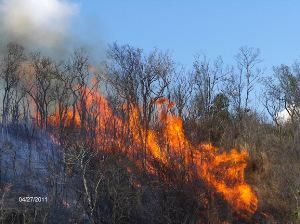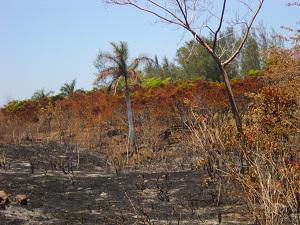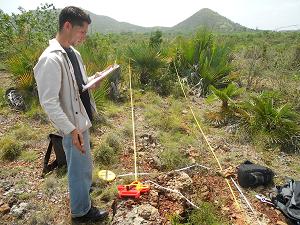Luis Roberto Gonzalez Torres
Other projects
Cuban serpentine thickets - the centre of diversity and endemism of the Caribbean hotspot - are being affected by an increase on wildfires frequency. This project will elucidate fire effects on these plant communities by comparing field data from non-burned and burned sites in a national study, and will provide a scientific basis for fire management and ecosystem conservation.

Fire.
Cuban serpentine thickets are the diversity and endemism centres of the Caribbean hotspot, and support the third richest serpentine flora in the world (after New Caledonia and Malaysia). Human-caused fires are increasingly frequent in these thickets, and the ecological effects of fire in tropical serpentine vegetation are almost completely unknown. According to preliminary data, fires are reducing the richness of native species and increasing the flammability of the serpentine vegetation. Both the composition and the structure of the fire-promoted thickets inhibit the natural recovery of the typical vegetation by limiting native plant recruitment. These results suggest that fires are shifting the rich Cuban serpentine thickets onto a pathway of fire-prone ecosystems, each one poorer in native species than its predecessor. These findings are quite different from any previous work on fires in Cuba, and also from other fire studies on serpentine vegetation worldwide. There have been almost no previous studies of fire ecology on serpentine soils in the tropics. This project will elucidate fire effects on these plant communities by comparing field data from non-burned and burned sites in a national study, and will provide a scientific basis for fire management and ecosystem conservation.

Recently burned-serpentine thicket, Havana, Cuba.
This project will set up a system of permanent paired, non-burned and burned plots in the serpentine outcrops of the lowlands – the serpentine areas most damaged by fires in Cuba. These plots will allow us to evaluate the role of fires in the composition, structure and functioning of Cuban serpentine thickets, determine primary vegetation areas for protection and the amount of fire damaged areas, identifying the environmental factors related to fire occurrence, classify and map areas by risk of fire according to the fire-prone factors identified, design an action plan for the conservation and management of lowland serpentine thickets, set up a baseline and a system for monitoring fires in these plant communities and the response of both non-burned and burned vegetation to climate change, training local conservationists in plant identification and monitoring methodologies, provide local and regional institutions with accurate data for planning and developing local initiatives to manage and preserve serpentine plant communities, raise awareness of local conservationists, managers and local technicians about the effect of fires on their serpentine plant communities and provide data, charts and images about the effect of fires in Cuban serpentine plant communities to support the work of local and regional environmental education activists and groups.

Sampling.